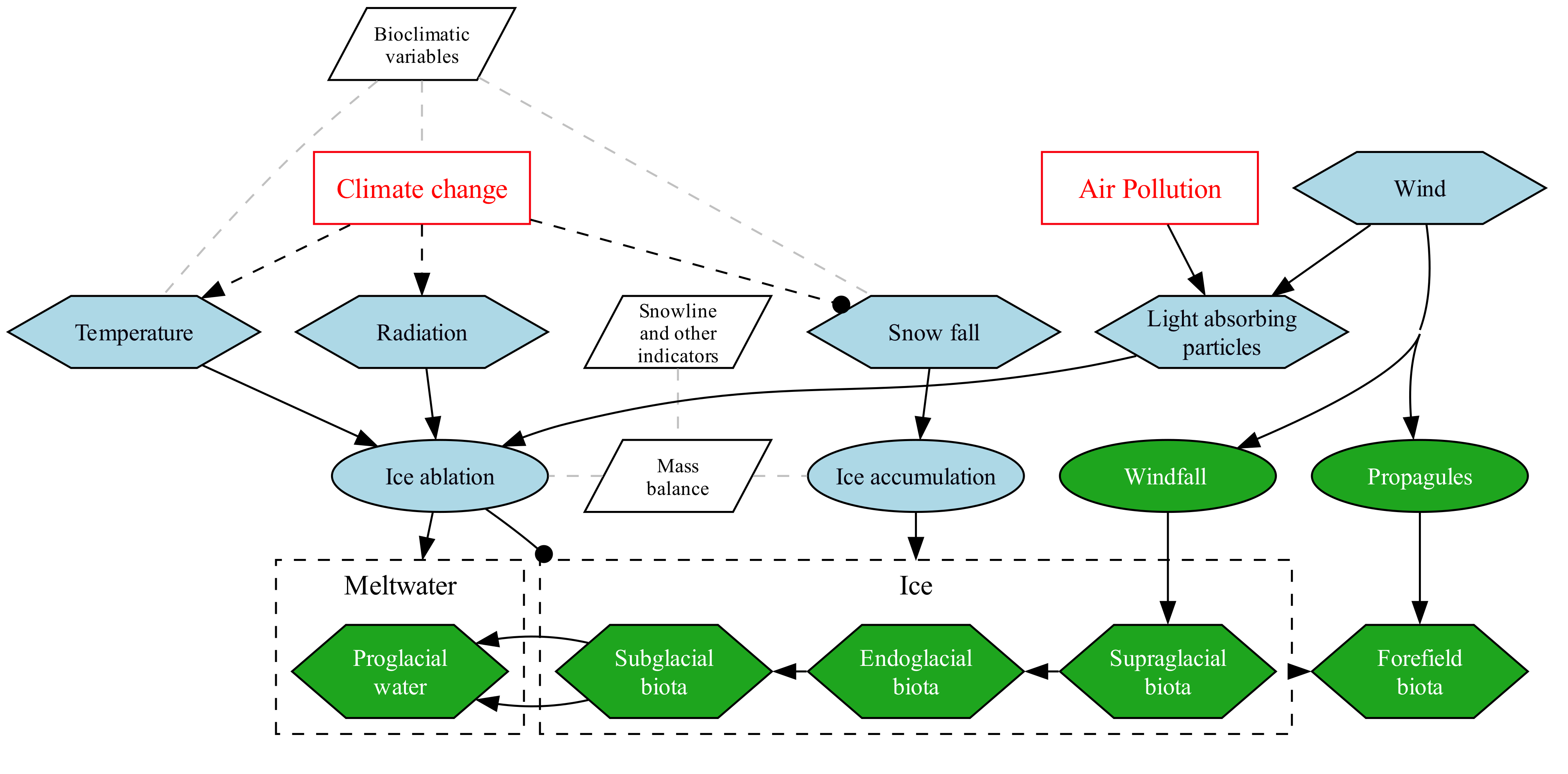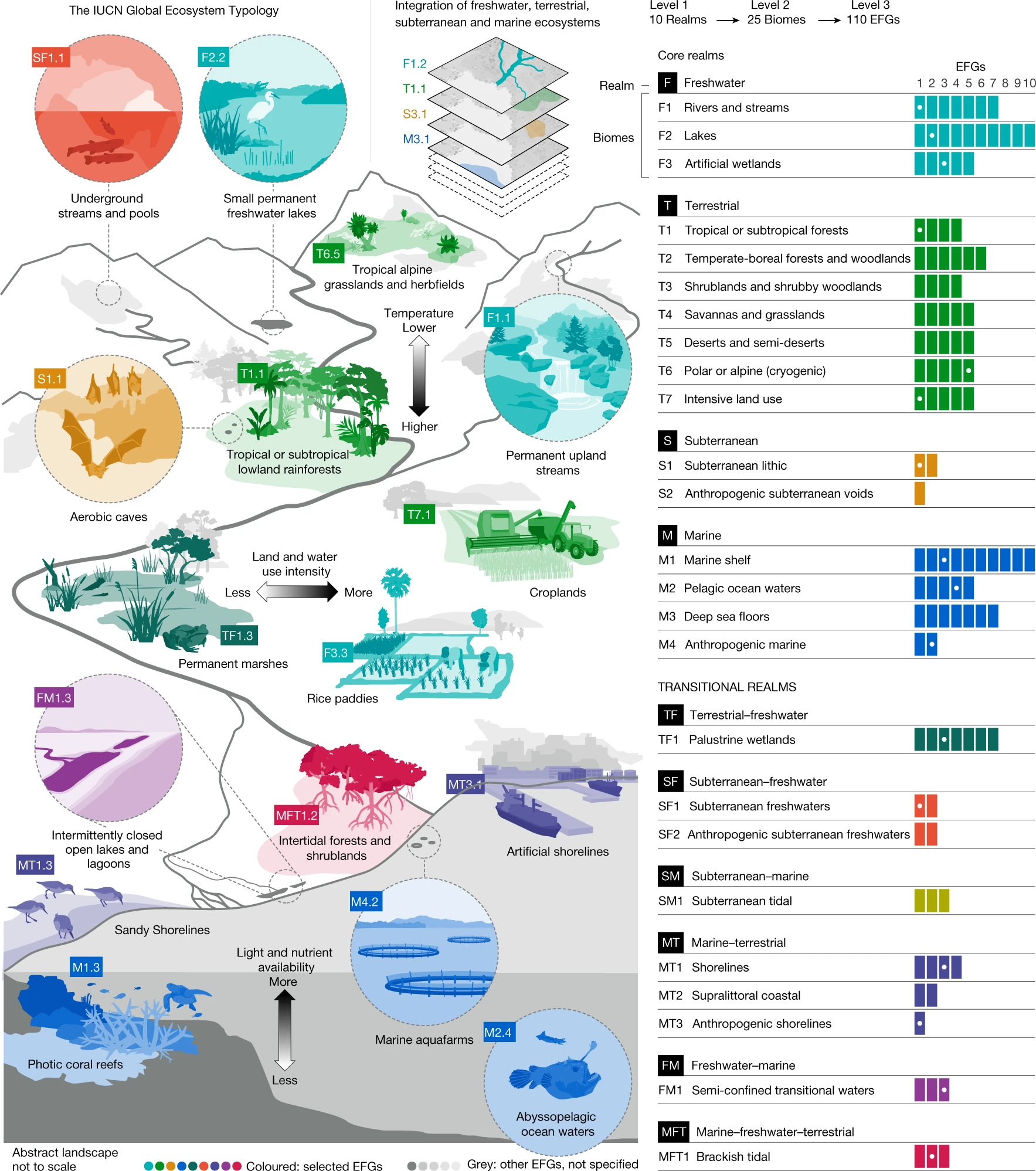Applications of the IUCN Red List of Ecosystems in research and conservation
University of New South Wales — Sydney
Outline
- What is the Red List of Ecosystems (RLE)?
- Role in the global biodiversity framework
- Contributions to ecosystem research:
- Conceptual ecosystem models
- Ecosystem typology
- Understanding collapse
- Risk assessment
What is the Red List of Ecosystems
Motivation for the Red List of Ecosystems
- Which ecosystems are most at risk of major changes involving diversity loss?
- What is the magnitude of the threats?
- Which changes are most likely to occur? Where? When?
D. A. Keith et al. (2015)
The RLE Team
The Red List of Ecosystems (RLE) is developed and implemented jointly by the IUCN Commission on Ecosystem Management (CEM) and the IUCN Science and Data Centre, in collaboration with the IUCN Species Survival Commission (SSC).
Prof. David Keith and Prof. Emily Nicholson lead the RLE Thematic Group.





What is the Red List of Ecosystems
A global standard for assessing the ecosystems’ risk of collapse
A global standard for assessing the ecosystems’ risk of collapse
“Ecosystems are complexes of organism and their associated physical environment within a specified area” - Tansley, 1935
A global standard for assessing the ecosystems’ risk of collapse
Probability of an adverse outcome over a specified time frame
A global standard for assessing the ecosystems’ risk of collapse
When it is virtually certain that it’s defining biotic or abiotic features are lost, and the characteristic native biota are no longer sustained
D. A. Keith et al. (2013)
Scientifically rigorous protocol
Guidelines for the application of IUCN Red List of Ecosystems categories and criteria (Bland et al. 2016, v 1.1). Updated version in preparation.
RLE Criteria

Using 5 criteria to diagnose different symptoms of collapse

Projected decline in area of one ecosystem type

Projected decline in area of one ecosystem type

Extent and severity of decline in biotic integrity for one ecosystem type
Applicable from local to global risk assessments
Key attributes of the RLE
- A standard method for assessing and comparing risk of ecosystem collapse
- Easy to comprehend by decision-makers and by public
- Transparent, objective and scientifically rigorous
- Applicable to terrestrial, marine, freshwater and subterranean realms
- Applicable from local to global risk assessments
- Flexible to use variable quality data and variable coverage
- Consistent and complementary to other knowledge products
Role in the Global Biodiversity Framework
Kunming-Montreal Global Biodiversity Framework (GBF)

Adopted during the fifteenth meeting of the Conference of the Parties (COP 15) following a four year consultation and negotiation process. This historic Framework, which supports the achievement of the Sustainable Development Goals and builds on the Convention’s previous Strategic Plans, sets out an ambitious pathway to reach the global vision of a world living in harmony with nature by 2050.
Goals and targets
- https://www.cbd.int/gbf/
- 4 goals for 2050
- 23 targets for 2030
Goal A
The integrity, connectivity and resilience of all ecosystems are maintained, enhanced, or restored, substantially increasing the area of natural ecosystems by 2050…
Four major contributions of the RLE

Contributions of the Red List of Ecosystems to different goals and targets of the Global Biodiversity Framework (Nicholson et al. 2024)
Robust framework for ecosystem science
RLE provides science-based concepts, definitions and criteria for assessing ecosystem risk
- Ecosystem types
- Ecosystem collapse
- Relative severity and extent of degradation (condition)
Catalyse knowledge synthesis
Knowledge synthesis, data collation, and structured analysis, provide valuable inputs for further research and decision making
Database of risk assessments
Risk assessment outcomes can inform priorities for a range of conservation and management actions

Using 8 categories to summarise risk or status of assessment
Global database of RLE assessments
Examples of published systematic assessments
Systematic national assessment of Myanmar (Murray et al. 2020)
https://www.myanmar-ecosystems.org/home

Examples of published strategic assessments
Tropical glacier of Cordillera de Mérida, Venezuela (José R. Ferrer-Paris et al. in press)
https://red-list-ecosystem.github.io/T6.1-SA-01-VE-01-Cordillera-Merida/
Knowledge sharing
Capacity building, knowledge generation, and knowledge sharing across countries, sectors, and within governments, supporting biodiversity mainstreaming
Contributions to ecosystem research
General assembly model for ecosystem types
Mechanisms
- Abiotic mechanisms
- Resource filters
- Environmental facots
- Perturbation regimes
- Biotic mechanisms
- Biotic interactions
- Human activity


Filtros y propiedades
- Emerging ecosystem properties:
- Ecosystem functions
- Ecological processes and structural properties
- Species (and community) traits


Interactions, dependencies and feedback loops

Example conceptual models: generic

Example conceptual models: specific

Conceptual Ecosystem Model for the Tropical glacier ecosystem of the Cordillera de Mérida (José R. Ferrer-Paris et al. in press)
A function-based typology
Versions
Principles of the typology
- Representation of ecological processes
- Representation of the biota
- Conceptual consistency
- Scalable structure
- Spatially explicit
- Parsimony and applicability
Synthesis and comparability
Knowledge transfer
Explore the webapp
global-ecosystems.org includes the three upper levels
5 Realms
25 Functional biomes
- Including 6 anthropogenic
110 Ecosystem functional groups
- Including 15 anthropogenic
Exploring the lower levels
Regional subgroups of ecosystem types
Example: Workshop with experts in preparation of assessment of Intertidal forests (Mangroves)


Ecosystem collapse
Ecosystem collapse
- Transformation of identity
- Loss of defining features
- Replacement by a new system
- May have some elements in common
- May be valuable
- May have some elements in common
Examples of collapsed ecosystem

Examples of global and local ecosystem collapse
Ecosystem collapse: symptoms
Transformation of defining features
- Ecosystem structure, dominance & composition
- Characteristic native biota (extirpations, invasions)
- Ecosystem functions & services
- Productivity
- Resource cycling (water, nutrients, carbon)
- Trophic diversity & structure
- Reduced resilience to environmental change
Reduced resilience

Resilient response to fire vs. ecosystem collapsed after underground mining and fire, from D. Keith et al. (2023)
Ecosystem collapse: symptoms
Emergence of a novel ecosystem
New set of defining features
New governing processes
Some elements in common with prior system
The case of the Aral sea
flowchart LR
FW["Freshwater\necosystem"]
ES["ephemeral\nsteppe"]
HS["hypersaline\nlakes"]
collapse((" "))
FW --->|"water\nextraction"| collapse --> ES & HS

Satellite images from the Aral sea in 1989 and 2014
Ecosystem collapse: mechanisms
Spatial processes
- Rates of spatial decline (rapid habitat loss ~ high risk)
- Land-use change: tropical forests
- Vulnerability to disasters (spatially explicit threat)
- Forests of Easter Island
Ecosystem collapse: mechanisms
Functional processes
- Physical degradation of the environment (suitability / heterogeneity - niche theory)
- Aral Sea
- Interruption of biotic processes (decreased functional complementarity, facilitation)
- Kelp forest, arid shrublands
Conceptual models of collapse

Conceptual model of ecosystem dynamics for groundwater-dependent, peat-accumulating wetlands with three states, from D. Keith et al. (2023)

Indicator responses for different collapse profiles, from Bergstrom et al. (2021)

Comparative study of collapse in 19 ecosystems in Australia and Antarctica, from Bergstrom et al. (2021)
Questions ?
j.ferrer@unsw.edu.au
This presentation was prepared by José R. Ferrer-Paris and is shared under license: Attribution-ShareAlike 4.0 International (CC BY-SA 4.0)
This presentation is available at:
jrfep.quarto.pub/iucn-rle-in-research-and-conservation.
It was created using RStudio, Quarto, y reveal.js.
Source code available at:
Photographs and images from gobal-ecosystems.org:
[1] "High cichlid fish diversity in Lake Malawi, Africa / Michel Roggo / [roggo.ch](http://www.roggo.ch)"
[2] "Frozen Lake, Ulriken, Bergen, Norway / Sveter on Wikimedia commons, CC BY-SA 3.0"
[3] "Cabo de Gata Nijar, Andalusia, Spain / Damocean / istock photo"
[4] "Giant kelp forest, Southern California / Brett Seymour / US NPS"
[5] "Mola mola (sunfish) near Nusa Lembongan, Indonesia / Ilse Reijs and Jan-Noud Hutten, CC BY 2.0"
[6] "Deep sea Anglerfish (_Himantolophus sp._) female with lure projecting from head to attract prey, Atlantic ocean / Nature Picture Library / Alamy Stock Photo"
[7] "Leopard seal on ice floe / Antarctic Climate and Ecosystems Cooperative Research Centre"
[8] "Blind cave fish, _Phreatichthys andruzzii_, southern Madagascar / Hectonichus on Wikimedia Commons, CC BY-SA 3.0"
[9] "Stygofauna from the Pilbara, Western Australia / Jane McRae / Western Australian Museum"
[10] "Anchialine Pond; Makena, Ahihi Kinau Natural Reserve, Maui, Hawaii / Design Pics Inc / Alamy Stock Photo"
[11] "Giant rosettes of Lobelia and Dendrosenecio in alpine herbfields, Rwenzori Mountains, Uganda / Rowan Donovan / National Geographic Image Collection / Alamy Stock Photo"
[12] "Multi-species plantation (shade coffee), Chikmagalur, India / Prashant Y on Flickr, CC BY 2.0" Wikimedia images: - Keith2013 process circle.png - AralSea1989 2014.jpg
Other figures from cited references.
R version 4.3.1 (2023-06-16)
Platform: aarch64-apple-darwin20 (64-bit)
Running under: macOS Sonoma 14.4.1
Matrix products: default
BLAS: /Library/Frameworks/R.framework/Versions/4.3-arm64/Resources/lib/libRblas.0.dylib
LAPACK: /Library/Frameworks/R.framework/Versions/4.3-arm64/Resources/lib/libRlapack.dylib; LAPACK version 3.11.0
locale:
[1] en_AU.UTF-8/en_AU.UTF-8/en_AU.UTF-8/C/en_AU.UTF-8/en_AU.UTF-8
time zone: Australia/Sydney
tzcode source: internal
attached base packages:
[1] stats graphics grDevices utils datasets methods base
other attached packages:
[1] jsonlite_1.8.8 dplyr_1.1.4
loaded via a namespace (and not attached):
[1] digest_0.6.33 utf8_1.2.4 R6_2.5.1 fastmap_1.1.1
[5] tidyselect_1.2.0 xfun_0.41 magrittr_2.0.3 glue_1.6.2
[9] tibble_3.2.1 knitr_1.45 pkgconfig_2.0.3 htmltools_0.5.7
[13] rmarkdown_2.25 generics_0.1.3 lifecycle_1.0.4 cli_3.6.2
[17] fansi_1.0.6 vctrs_0.6.5 withr_2.5.2 compiler_4.3.1
[21] tools_4.3.1 pillar_1.9.0 evaluate_0.23 yaml_2.3.8
[25] rlang_1.1.2 
46th Open Seminar Mammal Research Institute / Białowieża, Poland / 06 Feb 2024 / By: JR Ferrer-Paris @ UNSW Sydney


